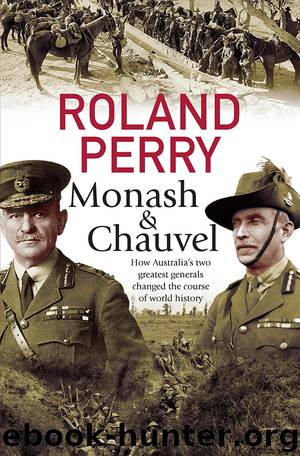Monash and Chauvel by Roland Perry

Author:Roland Perry
Language: eng
Format: epub
Publisher: Allen & Unwin
Published: 2017-09-14T16:00:00+00:00
Chapter 39
Rogue Warlord
By the night of 27 August, the Australian Corps had pushed its line another kilometre or so east past the villages of Fontaine, Vermandovillers and Foucaucourt on the main road. The latter had to be bombarded with artillery, and was only captured after a hard fight by 5th Division, demonstrating that pockets of Germans were prepared to stay and fight. The 2nd Division also found obstacles to their progress in Tivoli Wood.
The corps’ move extended north about 2.5 kilometres to the Cappy bend in the river, and included the crossing at Eclusier.
On 28 August the corps advanced more than a kilometre again, reaching the line Genermont–Berny-en-Santerre–Estrees–Frise. The next day all four divisions in the action had moved further east. The 3rd Division north of the Somme had seized the villages of Suzanne, Vaux, Curlu, Hem and Clery. The corps’ three divisions south of the river were in line with the 3rd and ‘stood upon the high ground sloping down to the Somme, with the river in sight from opposite Clery, past Péronne and as far south as St Christ’.1
The Australians set the pace of the conflict, and the Germans were again forced into a disorganised withdrawal. Guns, ammunition and stores were left in their wake. HQs, hospitals and dressing stations were abandoned like ghost sites, with equipment intact and missing one factor—people to operate them. Monash now had control of the whole of the Somme Valley from Clery (a village on the horseshoe river bend) westward, and was having bridges repaired. His background in construction was having an impact second only to his growing number of military achievements. The Germans destroyed bridges to impede the Allied pursuit; Monash rebuilt them. This gave him scope for options and different routes to his ultimate aims. If one route was blocked there were alternatives.
The rapidity of events was causing him to consider a plan he had held ever since 9 August when he took control of Chipilly Spur. He was in place north and south of the Somme. His aim was to take control of the line of the river from the east. If resistance was strong, his fallback plan was to make an assault from the north. He wanted to make the Somme useless to the enemy as a defence line, and force that final retreat to the Hindenburg Line.
Monash wished to do it without reliance or assistance from any other corps. It had to be ‘an exclusively Australian achievement’.2
•
Monash’s first object of desire in this plan was Mont St Quentin. It had to be taken, along with Péronne, 1.5 kilometres south. From a high point at the bend in the river, the mont looked harmless and did not stand out in the landscape. It reached about 110 metres at its apogee, and protected the northern way into Péronne. Possession of it meant control of approaches from all points of the compass. The hill was riddled with underground galleries and huge, well-furnished shelters. Domination of the hill—it was hardly a mont—also allowed command of both stretches of the river.
Download
This site does not store any files on its server. We only index and link to content provided by other sites. Please contact the content providers to delete copyright contents if any and email us, we'll remove relevant links or contents immediately.
| Africa | Americas |
| Arctic & Antarctica | Asia |
| Australia & Oceania | Europe |
| Middle East | Russia |
| United States | World |
| Ancient Civilizations | Military |
| Historical Study & Educational Resources |
Cecilia; Or, Memoirs of an Heiress — Volume 1 by Fanny Burney(32064)
Cecilia; Or, Memoirs of an Heiress — Volume 3 by Fanny Burney(31459)
Cecilia; Or, Memoirs of an Heiress — Volume 2 by Fanny Burney(31409)
The Secret History by Donna Tartt(18168)
Sapiens: A Brief History of Humankind by Yuval Noah Harari(13993)
Leonardo da Vinci by Walter Isaacson(12807)
The Radium Girls by Kate Moore(11624)
Sapiens by Yuval Noah Harari(5125)
How Democracies Die by Steven Levitsky & Daniel Ziblatt(4965)
The Wind in My Hair by Masih Alinejad(4847)
Homo Deus: A Brief History of Tomorrow by Yuval Noah Harari(4691)
Endurance: Shackleton's Incredible Voyage by Alfred Lansing(4508)
Man's Search for Meaning by Viktor Frankl(4291)
The Silk Roads by Peter Frankopan(4275)
Millionaire: The Philanderer, Gambler, and Duelist Who Invented Modern Finance by Janet Gleeson(4105)
The Rape of Nanking by Iris Chang(4024)
Hitler in Los Angeles by Steven J. Ross(3800)
The Motorcycle Diaries by Ernesto Che Guevara(3788)
Joan of Arc by Mary Gordon(3786)
